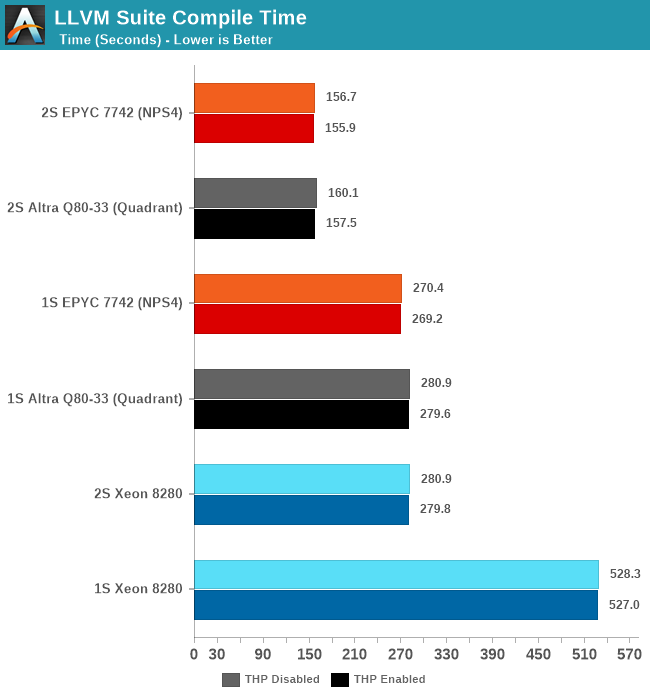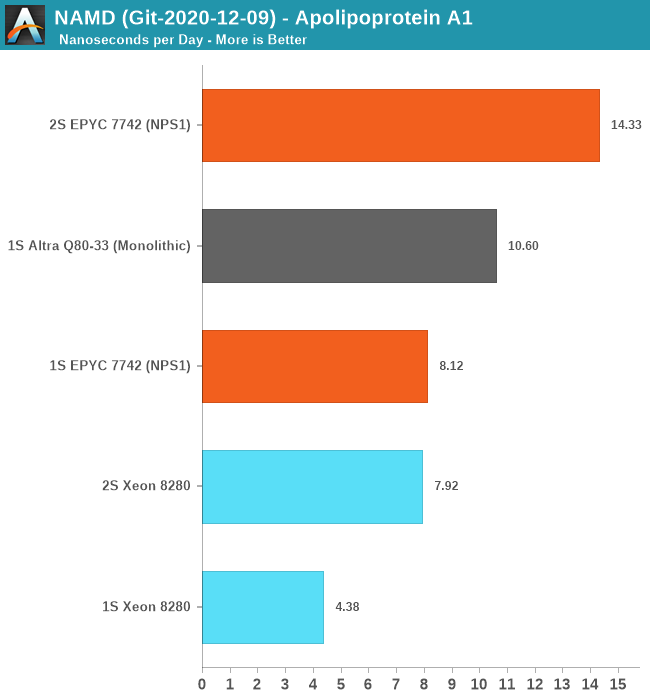The Ampere Altra Review: 2x 80 Cores Arm Server Performance Monster
by Andrei Frumusanu on December 18, 2020 6:00 AM EST- Posted in
- Servers
- Neoverse N1
- Ampere
- Altra
Compiling LLVM, NAMD Performance
As we’re trying to rebuild our server test suite piece by piece – and there’s still a lot of work go ahead to get a good representative “real world” set of workloads, one more highly desired benchmark amongst readers was a more realistic compilation suite. Chrome and LLVM codebases being the most requested, I landed on LLVM as it’s fairly easy to set up and straightforward.
git clone https://github.com/llvm/llvm-project.gitcd llvm-projectgit checkout release/11.xmkdir ./buildcd ..mkdir llvm-project-tmpfssudo mount -t tmpfs -o size=10G,mode=1777 tmpfs ./llvm-project-tmpfscp -r llvm-project/* llvm-project-tmpfscd ./llvm-project-tmpfs/buildcmake -G Ninja \ -DLLVM_ENABLE_PROJECTS="clang;libcxx;libcxxabi;lldb;compiler-rt;lld" \ -DCMAKE_BUILD_TYPE=Release ../llvmtime cmake --build .We’re using the LLVM 11.0.0 release as the build target version, and we’re compiling Clang, libc++abi, LLDB, Compiler-RT and LLD using GCC 10.2 (self-compiled). To avoid any concerns about I/O we’re building things on a ramdisk – on a 4KB page system 5GB should be sufficient but on the Altra’s 64KB system it used up to 9.5GB, including the source directory. We’re measuring the actual build time and don’t include the configuration phase as usually in the real world that doesn’t happen repeatedly.

The Altra Q80-33 here performs admirably and pretty much matches the AMD EPYC 7742 both in 1S and 2S configurations. There isn’t exact perfect scaling between sockets because this being a actual build process, it also includes linking phases which are mostly single-threaded performance bound.
Generally, it’s interesting to see that the Altra here fares better than in the SPEC 502.gcc_r MT test – pointing out that real codebases might not be quite as demanding as the 502 reference source files, including a more diverse number of smaller files and objects that are being compiled concurrently.
NAMD
Another rather popular benchmark tool that we’ve actually seen being used by vendors such as AMD in their marketing materials when showcasing HPC performance for their server chips is NAMD. This actually quite an interesting adventure in terms of compiling the tool for AArch64 as essentially there little to no proper support for it. I’ve used the latest source drop, essentially the 2.15alpha / 3.0alpha tree, and compiled it from scratch on GCC 10.2 using the platform’s respective -march and -mtune targets.
For the Xeon 8280 – I did not use the AVX512 back-end for practical reasons: The code which introduces an AVX512 algorithm and was contributed by Intel engineers to NAMD has no portability to compilers other than ICC. Beyond this being a code-path that has no relation with the “normal” CPU algorithm – the reliance on ICC is something that definitely made me raise my eyebrows. It’s a whole other discussion topic on having a benchmark with real-world performance and the balance of having an actual fair and balanced apple to apples comparison. It’s something to revisit in the future as I invest more time into looking the code and see if I can port it to GCC or LLVM.

For the single-socket numbers – we’re using the multicore variant of the tool which has predictable scaling across a single NUMA node. Here, the Ampere Altra Q80-33 performed amazingly well and managed to outperform the AMD EPYC 7742 by 30% - signifying this is mostly a compute-bound workload that scales well with actual cores.
For the 2S figures, using the multicore binaries results in undeterministic performance – the Altra here regressed to 2ns/day and the EPYC system also crashed down to 4ns/day – oddly enough the Xeon system had absolutely no issue in running this properly as it had excellent performance scaling and actually outperforms the MPI version. The 2S EPYC scales well with the MPI version of the benchmark, as expected.
Unfortunately, I wasn’t able to compile an MPI version of NAMD for AArch64 as the codebase kept running into issues and it had no properly maintained build target for this. In general, I felt like I was amongst the first people to ever attempt this, even though there are some resources to attempt to help out on this.
I also tried running Blender on the Altra system but that ended up with so many headaches I had to abandon the idea – on CentOS there were only some really old build packages available in the repository. Building Blender from source on AArch64 with all of its dependencies ends up in a plethora of software packages which simply assume you’re running on x86 and rely on basic SSE intrinsics – easy enough to fix that in the makefiles, but then I hit some other compilation errors after which I lost my patience. Fedora Linux seemed to be the only distribution offering an up-to-date build package for Blender – but I stopped short of reinstalling the OS just to benchmark Blender.
So, while AArch64 has made great strides in the past few years – and the software situation might be quite good for server workloads, it’s not all rosy and we’re still have ways to go before it can be considered a first-class citizen in the software ecosystem. Hopefully Apple’s introduction of Apple Silicon Macs will accelerate the Arm software ecosystem.










148 Comments
View All Comments
realbabilu - Friday, December 18, 2020 - link
well it support fortran also using Arm Fortran Compiler, unlike m1.realbabilu - Friday, December 18, 2020 - link
my bad. Numerical Algorithms Group (Nag) has fortran for m1. lets battle begin X86 vs armGruenSein - Friday, December 18, 2020 - link
The userbase for fortran on M1 is probably super small anyway. Although.. I can see the HPC cluster entirely made up of Macbook Airs before my eye. Just like the PS3-cluster the air force used to have ;)davidorti - Friday, December 18, 2020 - link
Wouldn't it be way cheaper a cluster of minis?Flunk - Friday, December 18, 2020 - link
No, the hardware would be cheaper but the maintenance would be much more time-intensive. That's why companies that need a lot of processing hardware buy enterprise level hardware. The cost of maintaining the system quickly eclipses the hardware costs. And if you're using a computer to make money, quite often the hardware cost is only a small amount of your costs.FunBunny2 - Friday, December 18, 2020 - link
I dunno about the "quite often the hardware cost is only a small amount of your costs." part. as modern production methods have been ever more automated, (I'm talkin to you, bitcoin mining), there's almost no other cost. now, some may argue, in the extreme case of mining for instance, that power is the largest component; but isn't that 'hardware' cost? it certainly isn't labor or interest or land or even CxOs' cut. fewer and fewer automation efforts are conducted in assembler or even naked C or java or FORTRAN, but in frameworks, often with bespoke syntax and with headcounts way lower than their native languages. so, yeah, now into the foreseeable future, hardware is the biggest byte.at_clucks - Friday, December 18, 2020 - link
The point was a cluster of Minis would probably be cheaper than a cluster of Airs because why pay for screen, battery, keyboard and all that.Spunjji - Monday, December 21, 2020 - link
True, but I did enjoy the holistic response. Just think of the potential: batteries are a built-in UPS, and you don't need to mess about with any sort of KVM arrangement - if a node drops out, you can go right to it and poke it to find out what's up!ProDigit - Saturday, December 19, 2020 - link
I guess the results showing lower TDP despite 100% load, means that the cores are sometimes idling for a part of their clock frequency.It means the cpu is lacking buffers, and isn't fully optimized.
mode_13h - Sunday, December 20, 2020 - link
Buffers and even cache can't completely avoid memory bottlenecks.Also, you can run a core 100% on code with very little parallelism and not draw much power. Code with lots of ILP and especially vector arithmetic burns a lot more power, which is why AVX2 and especially AVX-512 trigger significant clock-throttling on Intel.